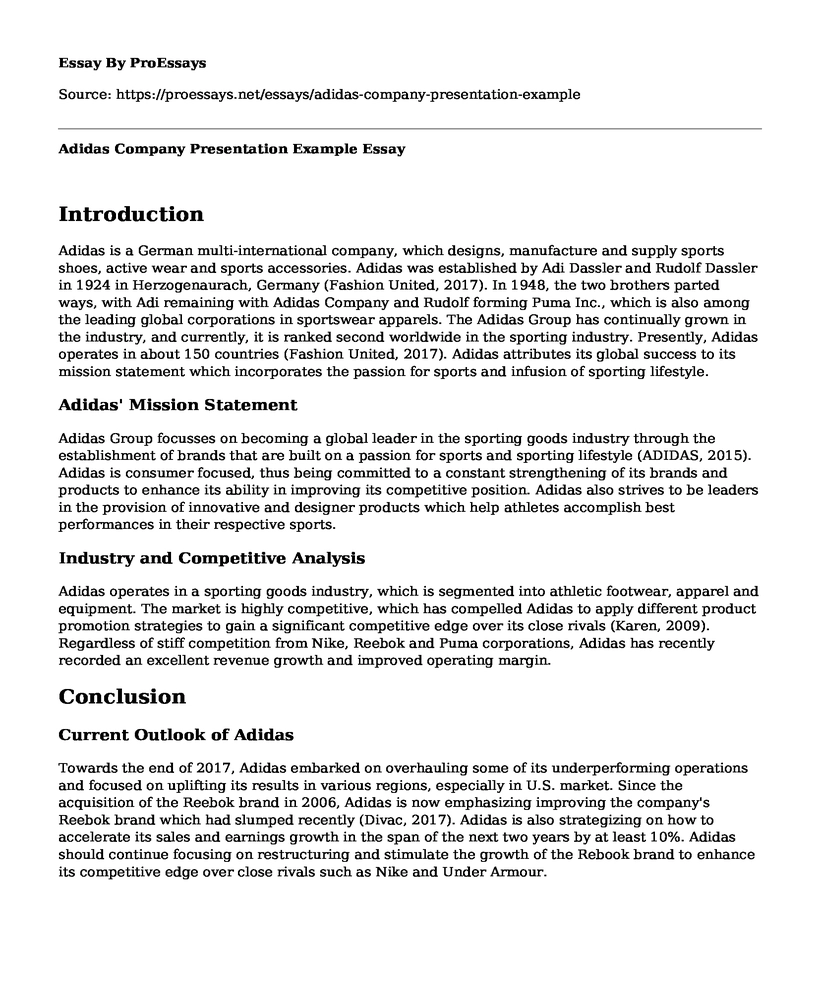Introduction
Adidas is a German multi-international company, which designs, manufacture and supply sports shoes, active wear and sports accessories. Adidas was established by Adi Dassler and Rudolf Dassler in 1924 in Herzogenaurach, Germany (Fashion United, 2017). In 1948, the two brothers parted ways, with Adi remaining with Adidas Company and Rudolf forming Puma Inc., which is also among the leading global corporations in sportswear apparels. The Adidas Group has continually grown in the industry, and currently, it is ranked second worldwide in the sporting industry. Presently, Adidas operates in about 150 countries (Fashion United, 2017). Adidas attributes its global success to its mission statement which incorporates the passion for sports and infusion of sporting lifestyle.
Adidas' Mission Statement
Adidas Group focusses on becoming a global leader in the sporting goods industry through the establishment of brands that are built on a passion for sports and sporting lifestyle (ADIDAS, 2015). Adidas is consumer focused, thus being committed to a constant strengthening of its brands and products to enhance its ability in improving its competitive position. Adidas also strives to be leaders in the provision of innovative and designer products which help athletes accomplish best performances in their respective sports.
Industry and Competitive Analysis
Adidas operates in a sporting goods industry, which is segmented into athletic footwear, apparel and equipment. The market is highly competitive, which has compelled Adidas to apply different product promotion strategies to gain a significant competitive edge over its close rivals (Karen, 2009). Regardless of stiff competition from Nike, Reebok and Puma corporations, Adidas has recently recorded an excellent revenue growth and improved operating margin.
Conclusion
Current Outlook of Adidas
Towards the end of 2017, Adidas embarked on overhauling some of its underperforming operations and focused on uplifting its results in various regions, especially in U.S. market. Since the acquisition of the Reebok brand in 2006, Adidas is now emphasizing improving the company's Reebok brand which had slumped recently (Divac, 2017). Adidas is also strategizing on how to accelerate its sales and earnings growth in the span of the next two years by at least 10%. Adidas should continue focusing on restructuring and stimulate the growth of the Rebook brand to enhance its competitive edge over close rivals such as Nike and Under Armour.
Future Outlook of Adidas
Adidas should position itself strategically to benefit fully from the ongoing digital revolution worldwide. Adidas should embrace digitalization, which has revolutionized marketing and sales strategies. Adidas should open new warehouse facilities in different countries where the company operates to enhance its e-commerce business. This will facilitate an increase in online sales.
References
ADIDAS. (2015). Mission, Vision and Values. ADIDAs, 1-2. Retrieved from http://adidasdeportivocolombia.blogspot.co.ke/2015/09/mission-vision-and-values.html
Divac, N. (2017). Adidas Shares Jump on Upbeat Growth Outlook. Market Watch, 1-3.
Fashion United. (2017). Company Description: Adidas. Fashion United, 1-3. Retrieved from https://fashionunited.com/i/company/adidas
Karen, B. (2009). Sport Management: Active Learning in Sport Series. Learning Matters.
Cite this page
Adidas Company Presentation Example. (2022, Jun 06). Retrieved from https://proessays.net/essays/adidas-company-presentation-example
If you are the original author of this essay and no longer wish to have it published on the ProEssays website, please click below to request its removal:
- Issue Identification: Analysis of an Ethical Issue Facing McDonald's
- Rational Decision-Making Model for Businesses Essay Example
- Strategic Alternatives to Diversification - Essay Sample
- Essay on Effective Communication: The Key to Successful Relationships and Organizations
- 2 Responsibilities for Each Position to Avoid HAC Penalty: Board Pres, CFO, CMO - Essay Sample
- Microsoft vs. Google and Apple: The Software War - Essay Sample
- Wireless Local Area Network: Improving the Value of IT in Daily Lives - Essay Example







